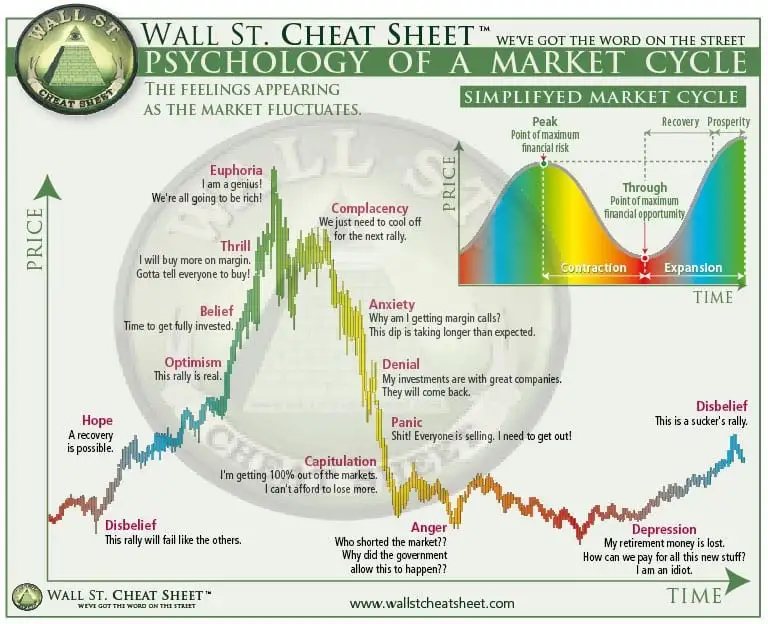Does using psychology in crypto benefit investors? Let’s find out.
As more crypto exchange platforms enter the fray, retail investors have easy access to crypto investments. People with minimal prior investment experience funnel millions into the crypto market, driving its explosive growth. This new crypto investor profile is entering a market characterized by little regulation, information asymmetry, and high volatility. The resulting friction and common psychological biases spark irrational behavior in cryptocurrency investment.
Human psychology and investing are intertwined. The potential for huge gains and losses in crypto intensifies a market condition driven by emotions rather than fundamentals. Common cognitive biases, from confirmation bias to FOMO, cloud investors’ judgment leading to irrational investment decisions.
Psychology of Crypto Investments
Cognitive biases are a natural part of human behavior and psychology. These biases develop due to our brains’ attempts to quickly streamline and process large amounts of information. These shortcuts are called heuristics. Unconscious and automatic responses shape our perceptions, thoughts, and decisions.
Cognitive biases also have an impact on our financial decisions. The psychology of an investor dictates how information is processed, what is prioritized, and ultimately, what has the most significant influence on their behavior. A field of study called behavioral finance focuses on this and investigates how psychology influences investors’ decision-making.

The Wall Street cheat sheet is a very useful indicator showing the impulses that drive each market cycle.
Psychological biases exist in traditional markets like the stock market, evidenced by the FOMO-enticing fiasco with Gamestop. However, cognitive biases heighten in crypto due to several specific factors.
Crypto Volatility
Crypto markets are known for being volatile and uncertain. As a result, there is a higher likelihood of cognitive biases developing in such an environment. Additionally, the possibility of making huge profits breeds irrational exuberance without sound judgment of potential losses. Follow this guide to understand crypto volatility and the factors that influence it in greater depth.
Emerging Market
The nascency of the market and the lack of substantial historical data compared to other well-established markets hinders the decision-making process.
Misinformation
Cryptocurrencies’ decentralized, strong community and global nature encourage the spread of both accurate and inaccurate information. This makes it challenging for investors to distinguish between true and false news, exacerbating cognitive biases.
Therefore, it’s beneficial to approach crypto investing by consciously avoiding “mental shortcuts.” Nevertheless, even seasoned investors frequently underestimate the probability of events occurring or give in to these biases. However, recognizing these biases and gaining perspective could keep investors’ portfolios above water.
Common Cognitive Biases
Mindset and Emotional Control are where 80% of success comes from in Trading & Investing. Reading charts is only 20% of it … if you make bad decisions it doesn't matter how good you are at reading a chart. #Bitcoin #Crypto #Psychology
— Kevin Svenson (@KevinSvenson_) November 12, 2021FOMO, or the Fear Of Missing Out
FOMO is a common psychological weakness among crypto investors. It is arguably the most widely discussed sentiment among crypto enthusiasts across social media platforms. The high degree of volatility and the strong community culture in crypto often create a sense of urgency among investors to make quick decisions to avoid missing out on potential gains.
Investors in cryptocurrencies frequently replicate other investors’ actions. FOMO is the root cause of this herd mentality. Unfortunately, this approach jeopardizes crypto investments because individuals are motivated more by the fear of missing out than by thorough research into the fundamentals of a project.
Investing with this sentiment and psychology often leads individuals to buy crypto assets at inopportune times. FOMO often results in investors ignoring red flags. This causes scammers to take advantage of this emotion to conduct fraudulent activities. Furthermore, market manipulation is a common byproduct of FOMO investing. This creates an environment where projects with no real-world utility are inflated in price.
Confirmation Bias
Humans often unintentionally seek out and interpret information in a way that supports and confirms their preconceived beliefs or assumptions. This is a common cognitive bias known as confirmation bias. This is a perilous trap to fall for when investing in crypto.
Despite social media communities being one of the central components of what makes the crypto ecosystem thrive, they have also become a fertile ground for spreading misleading information. Catchy headlines are frequently used to draw attention to baseless claims. Confirmation bias can result in investors neglecting objective analysis that contradicts their confirmation bias. This often leads to bad investment decisions and a failure to recognize possible risks.
It is, therefore, critical for investors in the space to combat this bias by seeking numerous sources of accurate information. Searching for both bullish and bearish perspectives could help individuals overcome their confirmation bias.
Sunk Cost Fallacy
The sunk cost fallacy occurs when investors cannot cut their losses because they have already invested money or time in an activity. Individuals often find themselves attempting to make up for lost time or money by spending more time or money rather than the reasonable decision to reassess their investment.
This bias frequently results in investors getting emotionally attached to their crypto investments, making it difficult to sell or cut losses. The attachment that comes with the bias, in turn, prevents individuals from rationally evaluating an asset’s potential to perform.
As a result, in addition to doing extensive research on a project’s fundamentals, it is crucial to keep an eye on the project’s roadmap, innovation, and upcoming events or developments that could impact its value. Furthermore, continuing to critically evaluate crypto projects from unbiased viewpoints and avoiding letting past investment decisions dictate future decision-making deters the dangers of sunk cost fallacy.

Loss Aversion
Psychological research suggests that people are more sensitive to avoiding losses than they are to the pleasure of achieving gains. When it comes to crypto investing, loss aversion bias appears in an investor’s psyche as an overwhelming sense of regret when selling an asset at a loss.
Loss aversion bias prevents individuals from acting rationally, even when selling the declining asset is the wisest option. Furthermore, in the hopes of recouping their initial investment or breaking even, individuals often invest more in the declining asset. This is because people are risk-seeking when faced with prospective losses yet risk-averse when faced with potential rewards.
Loss aversion accompanies risk avoidance. In crypto, this is a very high-risk play, as a myriad of projects in the past have lost all their value. According to CoinGecko, over 900 cryptocurrencies fail each year. To overcome this common bias, it is essential to understand that not all crypto investments result in huge profits and that losses are inevitable. Additionally, investors must avoid letting the fear of taking a loss influence their judgment.
Motivating Uncertainty Effect
Motivating-Uncertainty Effect is a common phenomenon in psychology where people are driven more by uncertain rewards than fixed rewards. Crypto investments are a high-risk and high-reward endeavor. The volatility of the crypto market, along with its potential to produce high returns, lack of regulatory oversight, and the relatively new technology underlying crypto, contribute to a higher level of ambiguity and unpredictability. This lures individuals to invest in higher-risk small-cap crypto assets despite their uncertainty.
A disciplined and strategic approach to investing is vital for overcoming this bias. For instance, when investing in highly speculative projects, it is advisable to conduct extensive research on the projects’ technology and utility, understand market trends, set realistic goals, and limit exposure to small-cap crypto assets in a diversified portfolio.
Conclusion – Psychology in Crypto Investments
The volatility in the crypto markets sparks unique emotional responses among investors, like excitement, greed, disappointment, or fear. Cognitive biases influence people’s actions and attitudes toward investing in cryptocurrencies. It is important to note that overcoming all of the aforementioned biases at once is incredibly challenging. However, becoming aware of them is an excellent first step towards joining the “smart money” circle. Awareness enables individuals to take action to counteract biases to make informed and rational investment decisions.




















